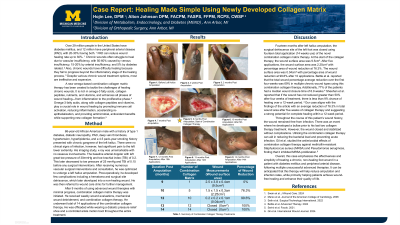Case Series/Study
(CS-082) Case Report: Healing Made Simple Using Newly Developed Collagen Matrix
Friday, May 2, 2025
7:45 PM - 8:45 PM East Coast USA Time

Introduction: Over 29 million people in the U.S. have diabetes mellitus, and 12 million have peripheral arterial disease (PAD), with 20-30% having both. PAD can reduce wound healing rate up to 30%. Chronic wounds often struggle to heal due to vascular insufficiency, with 50-60% caused by venous insufficiency and 15-20% by arterial insufficiency. Despite various chronic wound treatment options, most are ineffective. This case report investigates a chronic post surgical dehiscence wound after a hallux amputation that was resolved after using the newly developed omega-based combination collagen matrix therapy after 4 month of use.
Methods: A 68-year-old African American male with a history of type 1 diabetes, diabetic neuropathy, PAD, DVT, hypertension, hyperlipidemia, and a 4.5 pack-year smoking history presented with chronic gangrene of the left hallux. There were no clinical signs of infection, however, had significant pain to the left lower extremity. After receiving numerous vascular interventions, patient was able to undergo a left hallux amputation. Post-operatively, he developed few complications including a hematoma and surgical site dehiscence, which later developed into a non-healing wound. After 9 months of advanced wound therapies with minimal progress, combination collagen matrix therapy was initiated. Once a week wound evaluations, mechanical debridement, and collagen therapy were applied to the wound at an outpatient wound care center.
Results: The wound surface area was 9.5cm² prior to starting therapy. The percentage area of wound reduction was 76.3%, wound surface area of 2.25cm² after 5 applications. The percentage area of wound reduction was 99.6%, wound surface area of 0.04cm² after 10 applications. After 14 total application of the therapy, the wound site closed.
Discussion: Fourteen months after left hallux amputation, the surgical dehiscence site closed with combination collagen matrix therapy. This therapy, rich in omega fatty acids, collagen peptides, and nutrients, promotes wound healing. This case highlights its effectiveness and simplicity of treating chronic, non-healing wounds after multiple failed advanced therapies.
Methods: A 68-year-old African American male with a history of type 1 diabetes, diabetic neuropathy, PAD, DVT, hypertension, hyperlipidemia, and a 4.5 pack-year smoking history presented with chronic gangrene of the left hallux. There were no clinical signs of infection, however, had significant pain to the left lower extremity. After receiving numerous vascular interventions, patient was able to undergo a left hallux amputation. Post-operatively, he developed few complications including a hematoma and surgical site dehiscence, which later developed into a non-healing wound. After 9 months of advanced wound therapies with minimal progress, combination collagen matrix therapy was initiated. Once a week wound evaluations, mechanical debridement, and collagen therapy were applied to the wound at an outpatient wound care center.
Results: The wound surface area was 9.5cm² prior to starting therapy. The percentage area of wound reduction was 76.3%, wound surface area of 2.25cm² after 5 applications. The percentage area of wound reduction was 99.6%, wound surface area of 0.04cm² after 10 applications. After 14 total application of the therapy, the wound site closed.
Discussion: Fourteen months after left hallux amputation, the surgical dehiscence site closed with combination collagen matrix therapy. This therapy, rich in omega fatty acids, collagen peptides, and nutrients, promotes wound healing. This case highlights its effectiveness and simplicity of treating chronic, non-healing wounds after multiple failed advanced therapies.

.jpg)